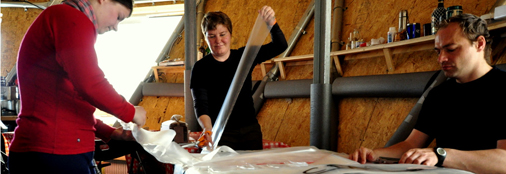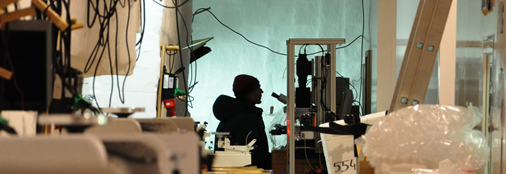27 May 2010
We begin an unpleasant task
 Processors, Maibritt, Marie and Peter, are preparing bags for brittle zone processing.
Processors, Maibritt, Marie and Peter, are preparing bags for brittle zone processing.
As the two most senior drillers, Jakob and Steff, have to leave next week, the drillers have to perform a number of tests on different settings and combinations of sections of the drill to ensure that drillers all summer have enough spare parts and options. We can therefore not expect that drillers will reach full production in the next few days. To give the drillers some peace, we have decided to go ahead and process brittle ice which has been stored since last year. All day, the processors have fought to get familiar with a new material: Ice with a lot of cracks resembling jig-saw puzzles. The cores are intact; but it requires diligence and a good blood circulation in ones fingers to keep all the pieces in place. Alli and Theo joined the processors and during the day, special holder and transport devices were developed, so that the ice may be moved without disintegration of the puzzle. Processors are now developing new routines to increase productivity.
Note on brittle ice:
Ice is compressed snow. It is full of bubbles of air trapped between the original snow crystals. It is this air that provides the global society with valuable and unique information on the content of green house gases in the atmosphere in past climates. The air in the bubbles undergoes compression as the ice layers sink, because pressure increases with depth in ice, just as in the ocean. In ice the pressure increases by 9 bar each 100 m depth. In 600 m depth, the pressure is close to 50 bar, and this pressure is so high, that the ice cannot withstand the strain. Spontaneous cracks are formed. We say, the ice is brittle. Ice from even greater depths is even more brittle; but nature is helpful. When pressure reaches 90 bar, the air is literary squeezed out of the bubbles and slides into the ice crystals, where the air molecules form a special chemical compound with the ice called chlathrate-hydrates, or crystal-water. The bubbles gradually disappear and at 1200 m depth, they are gone. The ice core is now crystal clear and strong. The depth interval between 600m and 1200 m is called the “brittle-zone”.
Ice is compressed snow. It is full of bubbles of air trapped between the original snow crystals. It is this air that provides the global society with valuable and unique information on the content of green house gases in the atmosphere in past climates. The air in the bubbles undergoes compression as the ice layers sink, because pressure increases with depth in ice, just as in the ocean. In ice the pressure increases by 9 bar each 100 m depth. In 600 m depth, the pressure is close to 50 bar, and this pressure is so high, that the ice cannot withstand the strain. Spontaneous cracks are formed. We say, the ice is brittle. Ice from even greater depths is even more brittle; but nature is helpful. When pressure reaches 90 bar, the air is literary squeezed out of the bubbles and slides into the ice crystals, where the air molecules form a special chemical compound with the ice called chlathrate-hydrates, or crystal-water. The bubbles gradually disappear and at 1200 m depth, they are gone. The ice core is now crystal clear and strong. The depth interval between 600m and 1200 m is called the “brittle-zone”.
Chlathrate-hydrates are only stable under pressure, so with time (a few months) bubbles re-appear. The trapped air can also be released by melting which is exploited in our CFA measuring system.
What we have done today:
- Drilling and logging.
- Processing ice cores.
- Removing snow drifts around storage garage..
- Measuring CFA. All analyses are working. Today we measured 19.8 m. Last bag 2469, 1357.95 m
- Making special handling tools for processing brittle core.
Ad.1: Drillers report:
Promising day in the drill trench with a production of 15.34 meters. Pressure tube “2” is now in service and produced two full runs to end the evening with good chip recovery. Lower current is used to drill with this motor section with runs proceeding with 7 to 9 amps rather than 10 to 12 (or current limitation) with a similar set up using pressure tube “1”. The hollow shaft configuration is set exactly to how we ended last season. In all cases a clean hole and a clean hollow shaft seem to be a requirement for good drilling, as short runs today seemed to be plagued by extra chips in the borehole.
Promising day in the drill trench with a production of 15.34 meters. Pressure tube “2” is now in service and produced two full runs to end the evening with good chip recovery. Lower current is used to drill with this motor section with runs proceeding with 7 to 9 amps rather than 10 to 12 (or current limitation) with a similar set up using pressure tube “1”. The hollow shaft configuration is set exactly to how we ended last season. In all cases a clean hole and a clean hollow shaft seem to be a requirement for good drilling, as short runs today seemed to be plagued by extra chips in the borehole.
Drillers depth: 1851.34 m
Ad.3: Processed 8 bags, from 2100 to 2107. Brittle zone processing. We have decided to skip the line-scanner in the brittle zone as this device only would pick up the cracks in the ice.
Weather: Thin overcast and fog/haze, in the evening clearing. -20°C to -13°C, 15-18 knots from S, in the evening 4 knots from SSW. Visibility: Between 3 miles and unrestricted.
Weather: Thin overcast and fog/haze, in the evening clearing. -20°C to -13°C, 15-18 knots from S, in the evening 4 knots from SSW. Visibility: Between 3 miles and unrestricted.
FL, J.P. Steffensen
 At the end of the science trench, in a quiet corner, Sepp studies the crystal structure of the ice.
At the end of the science trench, in a quiet corner, Sepp studies the crystal structure of the ice.
| ← Previous entry | Next entry → |

